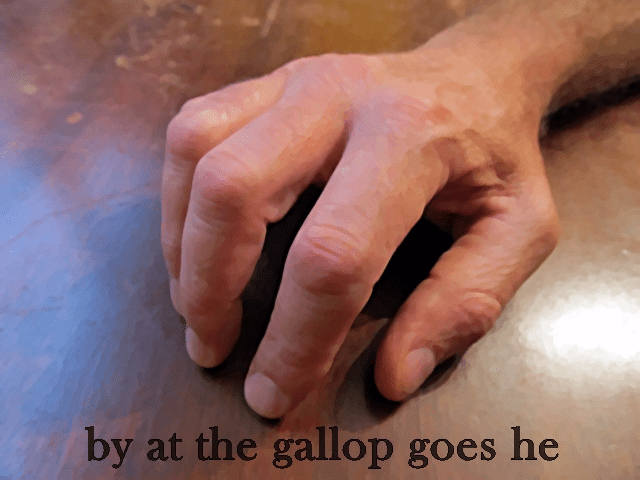
My father used to do something like Mr. Davenport but not to that extent. He also played the spoons.
Sometimes after dark he would drum his fingers on the table to make galloping horse sounds and recite:
Whenever the moon and stars are set,
Whenever the wind is high,
All night long in the dark and wet,
A man goes riding by.
Late in the night when the fires are out,
Why does he gallop and gallop about?
Whenever the trees are crying aloud,
And ships are tossed at sea,
By, on the highway, low and loud,
By at the gallop goes he.
By at the gallop he goes, and then
By he comes back at the gallop again.
Comment by Ed Ammons May 2013
———————
The poem Ed remembers his father reciting is Windy Nights written by Robert Louis Stevenson (1850-1894).
I wasn’t familiar with the poem until Ed left his comment back in 2013. I like the poem and I like the image of Ed’s father reciting it as he drummed his fingers.
Tipper


I loved The Highwayman! truth be told, I loved and still love poetry.
My dog needs a bath, but I fear he’ll never have another one from me without me singin’ “Give the Dog a Bath” and thinkin’ of Chitter and Chatter!
We learned on our father’s knee. Kids today learn from electronic devices. I prefer the old way!
Tipper,Can’t you find some fingers and voice to go along with that poem.Would love to hear it.Thanks Ed.God Bless.
Thanks for a great read and memory. Makes me want to go on a hunt for these treasures.
This was one of my favorite poems since childhood, from A Child’s Garden of Verse by RLS. It would convey such vivid pictures in imagination! I just enjoyed reading a book, called “A Wide and Starry Sky”, about him and his wife Fanny Osbourne, that I highly recommend if you like Robert Louis Stevenson.
Tipper,
I’ve never heard Ed’s dad’s poem
before, but I’ve seen folks tap on tables before, like a horse running.
I knew this older man once who use to write in the air, as if it was on paper. He did this while he was talking. Never did understand that…Ken
There is something neat about the rhythmic tappig of fingers on a table. It is especially memorable when a song is sung or a poem such as the one above is said out loud.
Good posting!
Good storytelling technique. Bet lots of your readers have poems or stories they tell with the enhancement of sound and motion to keep their listeners’ attention. Good poem for this.
Tipper,
I think my comment got lost again…Maybe I will write another one later…It was my remembrance about one of my favorite childhood poets, the rhythm/meter of the poem taught from my early school years……
Thanks Tipper,
and Ed
This reminds me of another favorite, “The Highway Man,” by Alfred Noyes.
“The wind was a torrent of darkness
among the gusty trees.
The moon was a ghostly galleon tossed
upon cloudy seas.
The road was a ribbon of moonlight
over the purple moor,
And the highwayman came riding—
Riding—riding—
The highwayman came riding, up to the
old inn-door.”
Tipper,
Robert Louis Stevenson is one of my very favorite poets from my childhood…(Does anyone remember the card game of Authors?) At any rate,
He creates rhythm with his choice of words in the poem…Tap your fingers in a gallop and recite the poem…You quickly learn the rhythm/meter of the poem. Sometimes adding a gallop after the last word in a line to keep up the rhythm to follow you on to the next line…You can’t go to fast or to slow…LOVE IT, LOVE IT!
A good teacher would use this poem as a teaching tool for a children’s class. Introducing rhythm and meter of a poem and have many children galloping across the desk with their fingers reciting the poem….LOL
A fun learning experience introducing poetry!
I dare say, many never forgot the poem or word expression used by Robert Louis Stevenson.
Thanks Tipper and Ed….
Hidden amongst the childhood memories is the life lesson of what matters. And part of it is that it isn’t what was ‘big’ at the time but instead the little and the ordinary becomes big in the heart’s accounting. As a grandpa I feel the responsiility to live with that in mind.
Thanks Tipper for the vision. It may seem odd I guess but your posts encourage me about the future.
Isn’t it funny how some things, like this, stick in our memories for a lifetime. There must be some emotion attached to the memories to make them stay.